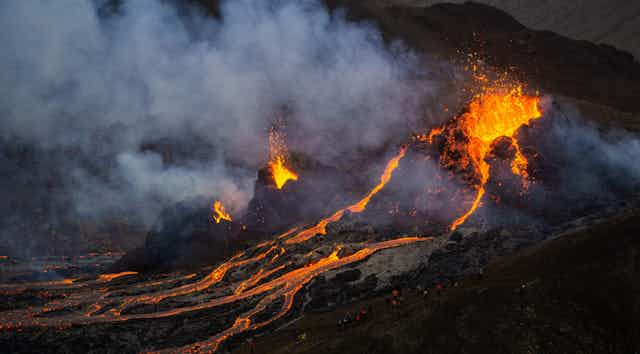The recent eruptions in Iceland, vividly captured through dramatic drone footage, have drawn public attention to the immense power of volcanoes. Beautiful though they are, and mesmerising to watch, they are also deadly.
History has recorded eruptions so spectacular they’ve never been forgotten. These include Krakatoa in 1883, whose explosion was heard around the world and Mount Tambora, which resulted in famines across the northern hemisphere.
But perhaps the most famous of all is the eruption of Vesuvius in Italy, in AD79, which sealed the Roman towns of Pompeii and Herculaneum beneath layers of ash.
Human activity has long been influenced by volcanic eruptions. Now, research into the variety of ways the skeleton reacts to heat is allowing us greater understanding of their impact on human death too.
The catastrophic impact of Vesuvius effectively froze the cities of Pompeii and Herculaneum in time, like insects trapped in amber. This has provided archaeologists with unique insights into the lives of those living in the shadow of the volcano thousands of years ago. The opportunity to actually walk around an ancient city, almost as it was, allows us to connect with our past in tangible ways.
The scientific study of the remains of victims of Vesuvius are, however, not without controversy. Until very recently, the prevailing theory was that the heat and force of the pyroclastic flow pouring out of Vesuvius caused the soft tissues to instantly vaporise.
This doesn’t make sense. We know from studies in modern crematoria and from archaeological excavations of incompletely cremated remains that the soft tissues don’t vaporise, even at hundreds of degrees celsius. Instead they slowly dehydrate, contract and fall away from the body.

Inconclusive evidence
Work at Pompeii and Herculaneum has shown the temperatures experienced following the eruption were around 300°C-400°C, certainly not as hot as in a cremation. Other recent research has also suggested fragments of brain and neurological tissues were preserved at Herculaneum. As exciting as this sounds, the evidence is actually rather inconclusive due to a lack of data, unusual protein preservation and insufficient reference to previously published work.
Bodies do change significantly when burned. Skin dehydrates and then splits to reveal the deeper tissues. The body is pulled into the famed “pugilistic pose” – like the contorted plaster cast figures created from the cooled ash of the Pompeii victims.
This appearance had previously been interpreted as the victim fleeing or fighting, but we now know it’s simply the consequence of the muscles contracting. The internal organs will shrink and be destroyed and the skeleton will be made visible.
For me, this is where it gets interesting. I have spent the past 20 years studying what happens to the skeleton when it is subjected to extreme heat. Unlike the soft tissues, the bones are not fully destroyed, nor are they turned to ash.

Extreme heat
Bones crack and fragment in different ways depending on whether soft tissue is present or absent. They change colour as the carbon is lost and warp and shrink as the microscopic crystal structure of the bone becomes active. This shrinkage can be as much as 30%.
In fact, we can use these heat-induced changes to interpret the context of death. For example, by calculating the intensity of burning from the extent of the changes or, as we did in a recently published paper from a Neolithic site in Sardinia, reconstructing the position of a body in relation to a fire.
Recent research by Italian scientists suggested the city of Pompeii was engulfed in only 17 minutes, causing the residents to suffocate to death. This supports our own work at the nearby town of Herculaneum.
Read more: South-west Iceland is shaking – and may be about to erupt
We combined new methods of studying bone collagen and crystal structure to show the people sheltering in the stone boat houses by the beach, rather than being vaporised, were in fact suffocated and baked to death.
Herculaneum is different to Pompeii in that the victims had longer to respond to the eruption, due to the location of the town. Analysis of the skeletons of the deceased shows many people ran to the beach to await evacuation by sea to safety.
Excavation and analysis of the skeletons suggest it was mainly men who died on the beach, while the women and children sheltered and ultimately died in the stone boat houses.
This gives us a poignant glimpse into not only who these people were, but how they lived their last moments – with the women and children sheltering and no doubt terrified as the temperature increased to fatal levels, while their husbands and fathers had been desperately trying to secure a means of escape.
Vesuvius didn’t just teach us about the living, it showed us what happens to bodies when they are hit by such a catastrophic geological force.

